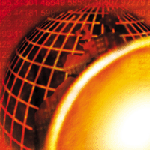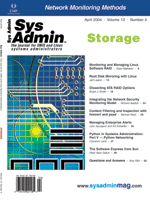 The
Software Express from Sun The
Software Express from Sun
Peter Baer Galvin
There was a time when Sun customers could receive SunOS on floppies
-- lots and lots of floppies. Loading that version was not much
fun. Then Sun began allowing customers to download current versions
of Solaris. And now, Sun has added to the fun by enabling downloads
of "snapshots" of future Solaris releases. The Software Express
for Solaris (SX) program allows existing Sun customers to download
an evolving release of Solaris. While writing three CDs worth of
downloads may not seem like fun to some, those of us who like experimenting
with new features and evaluating new functions now have a new way
to have a great time.
The difficult part of describing this new Sun access method is
that it has no equivalents, so it defies easy labeling. For example,
it's not a beta-test program. There is no application process, and
the software is fully supported, although it is "early-release"
software. The best way to consider this service is that, for free,
you can download snapshots of Solaris. These snapshots are versions
of Solaris that are not currently available any other way -- not
beta, and certainly not in a Sun box. Periodically, however, Sun
will capture one of these snapshots and package it, or something
like it, as a full Solaris release.
This month, I'll look at the Software Express (SX) program in
detail and explain how the program works, how well it works, and
what's in those snapshots.
Brief History
The SX implementation has been used at Sun for more than two years,
allowing engineers to exchange current versions of their code and
allowing systems administrators at Sun to get the latest builds
of Sun's software for installation on internal systems. In September
2003, Sun expanded its use to anyone outside the company who was
interested in trying these early releases.
Since then, there has been a predictable release every month.
There are more frequent internal releases but, of those, only the
best ones are made available for public consumption. Each release
must pass complete Sun release testing. At this time, more than
3000 individuals have registered and used SX.
How It Works
The software available includes SPARC and x86 snapshots of the
Sun Solaris development cycle. The download and use of SX and the
snapshots is under non-disclosure, because Sun wants to contain
discussion of features and bugs. (I received permission for this
column.) There are two access methods available. For free, the software
can be downloaded. However, there is no technical support available,
no discussion groups, no detailed roadmaps, and so on. It is strictly
a "give it a try" arrangement. For $99 per year, a user gets access
to the downloads as well as all of those other features. Bugs may
be submitted through a Web site, but not via phone. With paid access,
the operating system can even be used in commercial environments.
Note that with either package, feedback on bugs and features can
be given to Sun. Sun indicated that some sites are running these
releases in commercial, production environments. These customers
apparently felt that the new features outweighed the risk of running
a very new release. It is important to note that there will be no
patches released against the downloadable software. Rather, customers
are expected to download the next release, which should include
fixes to most of the bugs in the previous release. Overall, the
features of the $99 service are well worth the cost. One limit to
joining the program is that you need an existing right-to-use license
for Solaris on the machine(s) that will host SX releases. This is
not a way to run Solaris for free.
The downloads themselves are easy to manage. Of course, the files
are large, so a fast pipe is almost required. Sun provides a download
tool, but on Windows XP I had no luck getting it to work. Rather,
just using a Web browser and a cable modem brought the CD images
to my hard disk within an hour or so. I used Easy CD Creator to
write the images to CD, but any software that can create bootable
CDs should work. For English-language deployments, three CD images
are needed. Non-English language versions are also available and
require extra downloads. No tools or extra CDs are available. Documentation
is available from a password-protected section of http://docs.sun.com.
After the download, the rest of the installation looks just like
a "normal" Solaris rollout. All of the standard features are included,
plus the features Sun added after Solaris 9. The software can be
used for an initial install or upgrade.
Solaris Next
Evaluating the newly installed software took quite a bit of time,
as there are currently more than 200 features unavailable in Solaris
9. It includes the new TCP stack implementation (codenamed Fire
Engine), NFS V4, and a cryptography framework. It also has DTrace,
a wild new kernel trace facility. Of course, some things never change
-- I still had to run catman -w to index the man pages installed
on the system! According to the file /etc/release, the version I
tested was "Solaris 10 s10_46 SPARC", build 46 of Solaris 10. There
are several major new features in this release, including the following.
DTrace
The engineering team that worked on the DTrace system functionality
is proud of their new baby, as well they should be. They are running
a discussion group at BigAdmin (http://www.sun.com/bigadmin/content/dtrace)
and have posted some examples of DTrace use at comp.unix.solaris.
This tool should be invaluable to systems programmers and developers
who are debugging, performance tuning, or performance profiling
their programs. It will also help systems administrators determine
exactly what is happening on their systems. Of course, there is
a bit of work to be done first. DTrace is not simple to use and
requires an understanding of the "D" programming language to really
drive it. Its power is impressive, though, making the learning effort
worthwhile. The developers at Sun believe this tool makes Solaris
the most observable operating system in history. With DTrace, the
innards of Solaris are now available to debugging and probing.
"Fire Engine" Performance Enhancements
This major project is a re-architecture of the networking stack
to improve performance and scalability. The implementation involves
decreasing the number of locks involved in the network kernel code.
Some performance improvement is already evident (estimated at 10%),
with more coming as other aspects of the kernel are tuned to take
advantage of the new stack. The net result of these changes is that
the kernel will be able to drive fast networking HBAs at close to
theoretically maximum speeds -- a welcome improvement.
Solaris Cryptographic Framework
Solaris now has a core set of APIs and SPIs (service provider
interfaces) for user and kernel access to cryptography. It is based
on open standards (PKCS#11) and allows for general access to both
standard crypto libraries and crypto accelerators. Even without
the accelerators, the new facility improves encryption performance
significantly. The use of cryptography with Solaris should be easier
and more uniform in the future based on this new feature. Also,
Simple Authentication and Security Layer (SASL) is implemented,
as described in RFC 2222.
NFS Version 4
This release implements a new standard NFS protocol, as specified
in RFC 3530. It solves lots of long-standing issues in NFS, including
file locking, NFS through firewalls, and security. It's also integrated
with Kerberos V5 (SEAM).
Solaris Privileges
This new security implementation requires appropriate privileges
for administrative tasks, not just superuser rights. It restricts
processes to only those privileges that are required to perform
a task. Sys admins can limit a program's access using the least
privilege capability. There is also an API to access the privileges.
Unmodified programs that run as root still have all privileges,
but programs written to use this new facility are more secure and
have fewer access rights. Many native programs have already been
rewritten, so there are fewer setuid and setgid programs. A quick
count showed 79 setuid and 26 setgid on the new system. This is
far fewer than previous releases, believe it or not. Furthermore,
devices now have a separate security policy. Permissions on a device
file do not fully determine access to the device. Privileges might
also be required for access to the device.
Many smaller changes to Solaris 9 can also be found in the latest
SX release as listed in the accompanying sidebar. Amazingly, this
is just a partial list of the new features found in SX that are
headed for the official "Solaris Next" operating system release.
Conclusions
With the Software Express program, Sun has given systems administrators
and developers a powerful new tool -- access to the future, today.
The SX program is easy and cheap, and therefore very likable. The
releases seem solid, with plenty of new features. Early access to
these features will aid developers in writing more secure, efficient
code, and aid administrators in planning future Solaris deployment
and testing new features. Some folks find enough value in the new
features to use these releases in production, which is certainly
a strong vote of confidence.
Future snapshots will include performance improvements, Trusted
Containers, and a new file system, plus quite a bit more. It's certainly
worth the time, money, and effort to be involved in this program
if your site is a heavy user of Solaris or is thinking about switching
to or expanding use of Solaris.
For more information about SX, see:
http://wwws.sun.com/software/solaris/solaris-express/sol_index.html
Acknowledgements
Some information for this column was provided by very helpful
people at Sun. They want to get the word out about SX and hope its
success will lead to other software being included in the Software
Express program. They include Bill Moffitt, Group Manager for Solaris
Product Management; Jackie Bao, Product Line Manager for Software
Express for Solaris' and Jill Berman, PR Manager at Sun.
Peter Baer Galvin (http://www.petergalvin.info) is the
Chief Technologist for Corporate Technologies (www.cptech.com),
a premier systems integrator and VAR. Before that, Peter was the
systems manager for Brown University's Computer Science Department.
He has written articles for Byte and other magazines, and
previously wrote Pete's Wicked World, the security column, and Pete's
Super Systems, the systems management column for Unix Insider
(http://www.unixinsider.com). Peter is coauthor of
the Operating Systems Concepts and Applied Operating
Systems Concepts textbooks. As a consultant and trainer, Peter
has taught tutorials and given talks on security and systems administration
worldwide.
| 
